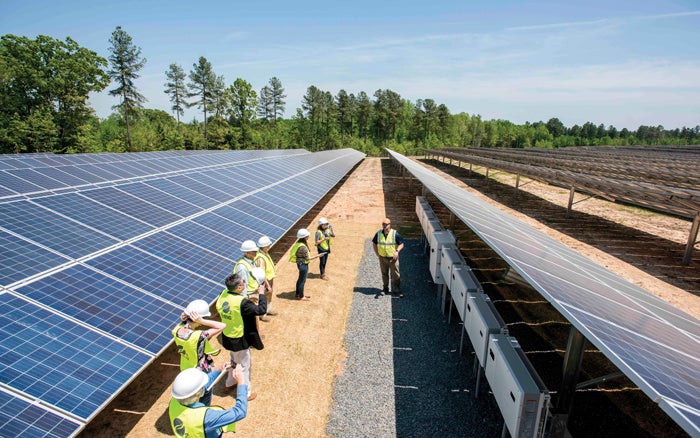Guest columnist: Solar deals making Duke bills higher
Published 1:26 am Thursday, April 11, 2019

- JON C. LAKEY / SALISBURY POST Brad Micallef, right, operations and maintenance director for solar operations, leads one of the tours in the new solar farm. O2 EMC Solar offered a short tour of their newest solar farm project that is currently under construction on Dunns Mountain Road in Rowan County in 2018.
By Donald van der Vaart
Roughly $1.25 billion. That’s how much Duke Energy customers will be overpaying for electricity over the next 10 to 15 years.
We can thank North Carolina law — and Gov. Roy Cooper — for the higher bills that come with long-term solar energy contracts Duke has been forced to accept. That’s not only bad for Duke’s customers, but it puts the utility at odds with a different state law that obligates Duke to seek the lowest-cost electricity and to maintain reliability.
For nearly two years, Duke officials have warned about the root cause of the higher bills, which stems from North Carolina’s interpretation of a federal law known as PURPA. The law requires the utility to buy solar power at old, high rates even though costs for other types of energy have dropped significantly since the old rates were negotiated. States have considerable discretion with PURPA, and because of North Carolina’s very favorable interpretation, our state now has more PURPA contracts for solar power than any other state in the nation.
In April 2017, Kendal C. Bowman, vice president of Regulatory Affairs and Policy for North Carolina for Duke Energy Carolinas and Duke Energy Progress, characterized solar power growth under North Carolina’s generous interpretation of PURPA as “uncoordinated and unrestrained.” She told utility regulators they should be concerned about two adverse impacts.
First, Bowman noted that under PURPA contracts, Duke was forced to buy any and all power generated by the qualified plants, whether the utility needed it or not, and at prices significantly higher than the cost at which Duke could generate electricity. Duke customers, she testified, are already on the hook for $1 billion in overpayment for electricity over the remaining term of existing contracts.
Second, Bowman explained that the more solar power is added to the grid the more difficult it becomes to maintain stability. The reason is simple. When the sun shines, power is generated, and Duke is required to buy it and quickly see-saw from one source to another.
The good news is that the General Assembly listened to Duke’s concerns. The result was House Bill 589, passed in July 2017. While the legislation included concessions to both the utility and the solar lobby, it amended North Carolina’s interpretation of PURPA. That change would have reduced the number of solar contracts and the price paid by Duke as of Sept. 1, 2017. That change would have translated into an estimated $850 million in savings. The bad news is that months later, as reported by WBTV, Cooper pressured Duke to sign a settlement with the solar industry that gutted much of the customer relief included in H.B.589. In other words, the industry wanted as many projects as possible to be exempt from the new law, even though the law would reduce the bills for Duke customers. Records show the CEO of N.C.’S largest solar company, Markus Wilhelm, reached out to Cooper, asking him to call “Duke leadership” to bring about a settlement of the dispute. According to WBTV, Cooper then used a critical permit that Duke needed for the Atlantic Coast Pipeline as leverage in the deal between Duke and the solar companies.
If the solar settlement was signed under duress, the legislature should nullify the agreement. In the meantime, Duke should be thanked for resisting efforts to unnecessarily raise our electricity rates.
Donald van der Vaart is a senior fellow at the John Locke Foundation and former N.C. environmental quality secretary.

